Found 133 results.
…st patients in external events more readily than the psychotherapeutic tête-à-tête. This happened, for example, with a thirty-year-old hebephrenic, whose illness had lasted seventeen years. In the group, she frequently paid no attention to the others’ conversation, being fully occupied with the question whether the doctor in charge was God or the Devil. On several occasions when she voiced her insane notions aloud, seeing every action of this ther…
By:
admin
…se contact with patients can develop. Too often this type of man is a ‘nine-to-fiver’ who literally does not comprehend the concept of true and total responsibility for a sick individual. To this type of pseudo-clinician the patient is seemingly born upon entering the hospital, and for all practical purposes does not exist after being discharged. His comprehension of the adaptive problems that await the discharged hospital patient is woefully inad…
By:
admin
…ective, adequate treatment time is essential and only a patient who is well-to-do or benefits from a generous insurance policy can afford that. Under present conditions, what are the prospects for a patient who suffers from a medium to severe emotional disturbance and who, like many others, has not benefited in any major way from the new mood-altering drugs? My estimate, shared by a number of expert colleagues, is that his chances of encountering…
By:
admin
…continue to put somatic health and mental health in opposition. Such an out-of-date division leads to separating physical and mental factors of a disorder. It amounts to a naive version of the psychosomatic approach, according to which disorders without organic etiology were considered of psychological origin and patients were evaluated as not truly sick individuals but as ‘hysterics’ ripe for the psychiatrist. The concept of holistic health calls…
By:
admin
…lth treatment and developing more effective methods, affordable even to low-income wage earners.” The volume is presented within the series In Search of the Future as a companion to Crucial Choices—Crucial Changes: The Resurrection of Psychotherapy, published in 2001. It contains 22 essays divided into four main parts. Part 1 contains essays offering a European point of view; part 2 enquires into the future of psychoanalysis and psychotherapy in t…
By:
admin

…s of teamwork that a new fashion is beginning to develop: the fashion of co-therapies, which combine psychoanalytic psychotherapies, more or less brief, with behavioural or so-called cognitive approaches or hypnotherapy—mainly in its Ericksonian form, body approaches—not to mention group therapies. Such practices are justified in the mind of those who recommend them because classical psychoanalysis cannot be applied in a hospital setting. It is th…
By:
admin
…the insurance-regulated system, up to a maximum of 300 sessions; four-times-a-week analysis is only allowed for a limited period of time due to medical reasons. The lack of substantial scientific-based evidence of the impact of sessions’ frequency on outcome shows repercussions (Grawe et al. 1993; Kachele and Thomä 1994). However, the psychoanalytic-oriented treatments make up for the majority of insurance-based treatments. The current main topic…
By:
admin
…to futures as child psychiatrists, in pediatrics. In the three to three-and-a-half years of specifically psychiatric training experience, major rotations exist through inpatient services which are no longer psychotherapy focused but rather are drug-management focused since lengths of stay are rarely, except in some very specialized clinical centers, longer than 30 days; through outpatient emergency rooms and crisis clinics and acute inpatient emer…
By:
admin
…ytic therapist has not wondered at times, especially with certain obsessive-compulsive patients, how better to summon feelings with which to enliven and make useful the patient’s many ideas? Direct bodily intervention might just be such a way, as Wilhelm Reich adumbrated in his ideas of character being armored in the body. Consciousness, will-power, positive thinking In opposition to the traditional psychoanalytic attention to unconscious forces e…
By:
admin
…1990). One of the trends that is already in evidence is the move to a three-times-weekly schedule as normative, despite the best efforts of the American Association to maintain a four-times-weekly standard (Richards 1990). The news from the medical side is not encouraging either. The role and centrality of psychoanalysts and psychoanalytic thinking in psychiatric residencies is falling dramatically. The level of qualified medical applicants for ps…
By:
admin
…hatever their symptoms, must share a type of distress that responds to the components common to all schools of psychotherapy. A plausible hypothesis is that patients seek psychotherapy not for symptoms alone but for symptoms coupled with demoralization, a state of mind characterized by one or more of the following: subjective incompetence, loss of self-esteem, alienation, hopelessness (feeling that no one can help) or helplessness (feeling that ot…
By:
admin
…at the psychoanalytic mainstream is beginning to show the maturity and self-confidence which are required to open itself to such challenge. References Dahl, H. (1988) ‘Frames of mind’. In H. Dahl, H. Kächele and H. Thomä (eds) Psychoanalytic Process Research Strategies. New York and Berlin: Springer- Veriag. Dahl, H., Holzer, M. and Berry, J. (1992) How to Classify Emotions for Psychotherapeutic Research. Ulm, Germany: University ofUlm Press. Deve…
By:
admin
…grams for at-risk youth. Youth employment and recreation programs, domestic-violence-reduction initiatives, and community policing have proved to be great assistance in many communities in the country. (3) Schools. Schools are also in a unique position to emphasize youth violence-prevention strategies. First, among these initiatives is to provide an education adequate for the postindustrial state. This includes an adequate physical plant, a releva…
By:
Dr. Raymond B. Flannery Jr.
« Previous
1
…
3
4
5
 From our online Publications
From our online Publications







 From AMHF
From AMHF 

 Host Companion
Host Companion